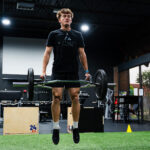Sports Specific Training for Multi-Sport Athletes
Playing multiple sports is a major advantage for developing athletes. It builds coordination, reduces burnout, and sharpens competitive instincts. However, juggling different physical demands requires smart programming—and that’s where sports specific training comes in.
At every level, multi-sport athletes need training that adapts to the season while preparing them for what’s next.
The Unique Needs of Multi-Sport Athletes
Multi-sport athletes are constantly switching gears. Fall may mean football, winter could bring basketball, and spring introduces baseball or track. Each sport demands different skills, movements, and recovery needs.
Without a plan, this constant shift can cause overuse injuries or plateaued performance.
That’s why sports specific training is essential. It ensures your body keeps progressing no matter what sport you’re playing.
Benefits of Sports Specific Training for Multi-Sport Athletes
1. Balanced Muscle Development
Sports training helps build strength evenly, avoiding muscle imbalances caused by repeating the same movement patterns.
2. Injury Prevention
By customizing mobility and strength work, athletes reduce risk from repetitive stress and overtraining.
3. Smarter In-Season Support
In-season programs focus on maintenance and recovery—not breaking the body down.
4. Improved Transitions
A tailored plan eases the switch between sports by adjusting conditioning and skill focus.
5. Long-Term Athletic Success
Early sport specialization can hinder development. Multi-sport training builds more complete athletes.
Year-Round Sample Plan for Multi-Sport Athlete
| Season | Sport | Sports Specific Focus |
|---|---|---|
| Fall | Football | Strength + Power + Recovery |
| Winter | Basketball | Agility + Jumping + Shoulder Stability |
| Spring | Baseball/Track | Rotation Power + Sprint Speed + Mobility |
| Summer | Offseason/Prep | General Strength + Speed + Injury Prevention |
Training evolves, but the foundation remains: support the athlete through every phase.
Key Components of Sports Specific Training
Pre-Season
-
Increase strength and speed
-
Improve energy systems used in sport
-
Focus on movement quality
In-Season
-
Maintain strength
-
Support recovery
-
Address sport-specific wear (e.g., knees in basketball)
Offseason
-
Build general athleticism
-
Correct imbalances
-
Prepare for next sport’s demands
Example Exercises for Multi-Sport Athletes
Single-Leg Box Jumps
Purpose: Build power and balance
How to do it: Stand on one leg, jump onto a low box, and land softly. Repeat for 3 sets of 6 reps per leg.
Trap Bar Deadlifts
Purpose: Total-body strength
How to do it: Stand in trap bar, grip handles, stand tall. 3 sets of 5 reps with good form.
5-10-5 Shuttle
Purpose: Agility and acceleration
How to do it: Sprint 5 yards, backpedal 10 yards, sprint 5 yards. Repeat 3 times.
Banded Lateral Walks
Purpose: Hip and knee stability
How to do it: Place resistance band above knees. Step sideways in a squat for 3 sets of 10 steps per side.
Medicine Ball Rotational Throws
Purpose: Core and rotational power (great for baseball, football, hockey)
How to do it: Throw ball into wall with power, rotate through hips. Do 3 sets of 8 reps per side.
Managing Load and Recovery Across Sports
With so many overlapping demands, rest and recovery are crucial. A well-managed training plan includes:
-
Active recovery days with light mobility
-
At least 1–2 full rest days weekly
-
Seasonal deload weeks
-
Emphasis on sleep and nutrition
The NSCA recommends that multi-sport youth athletes limit high-intensity sessions to 4 per week, especially during in-season play.
How Next Level Athletics Supports Multi-Sport Athletes
Next Level Athletics specializes in building custom training plans for athletes playing 2–3 sports.
Their programs include:
-
Transition planning between sports
-
Year-round athletic tracking
-
Custom strength and speed cycles
-
Injury prevention strategies
-
Communication with coaches and parents
Whether you play volleyball and softball or football and track, Next Level keeps you strong, balanced, and progressing all year long.
Real Results Across Multiple Sports
Athletes training with a sports-specific focus at Next Level have gone on to:
-
Reduce their injury rates
-
Improve vertical and sprint times
-
Excel in multiple varsity sports
-
Compete in college with a broad athletic foundation
The key? Training that evolves with the athlete—not just the season.
Conclusion: Train for Longevity and Versatility
If you’re serious about long-term success across sports, sports specific training is a must. It keeps you balanced, strong, and competitive, whether you’re changing cleats for court shoes or swinging bats after shooting threes.
With smart planning and consistent effort, multi-sport athletes can thrive year-round—without breaking down.
Train with purpose. Compete with confidence.


Recent Comments